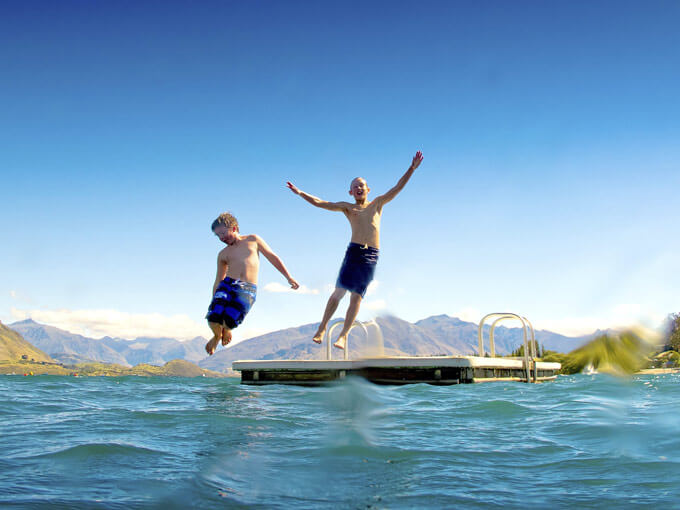Jan 11, 2019 Books
New Zealand through a swimmer’s eyes.
The quotidian record is interspersed with snippets, facts and tales of waterways and swimming — outdoor swimming that is, “not its distant cousin: pee-warm, chlorine-soaked indoor-pool swimming”. For only outdoor swimming, writes Lees, provides “that singular crucible for joy and fear that so refreshes our soul”.
One or two of Lees’ swims, it has to be said, would seem not to technically qualify as such, but readers will admire her feint. Her diary entry from August 21 reads: “The flu rages. I can hardly leave the couch, let alone the house. A swim seems out of the question. So I fill the bath with mineral salts and the rainwater from our tank—does that make it count? I open the window wide to the starry night. Max [dog] sits outside the window. These things make it a swim, and officially wild, surely.”
The genesis of the author’s year-long mission was born of self-loathing. Swimming had been “a consistent life companion”, she writes, but one February, she found that summer had passed her by and that “her inner seven-year-old would be contemptuous of her lack of swimming”. Once she commenced her self-imposed regime, she “started to see New Zealand through swimming eyes”.
Aotearoa is a watery place: 425,000km of streams and rivers; 50,000 lakes; 300 estuaries; and many stories in which they feature. George Selwyn, the country’s first Anglican bishop from 1841 to 1858, for example, was a top swimmer; in England he had been the president of the Psychrolutes Club, an elite branch of Eton College’s Philolutes, or lovers of bathing. In New Zealand, Selwyn liked to say, “Fancy yourself a dart”, when diving into the Firth of Thames.
At various times in Swim Lees references a far more perilous waterway, Cook Strait. In the 18th century, Hinepoupou, from Rangitoto (d’Urville Island), swam the strait in three days, with harekeke (flax stems) tied around her waist as flotation devices. Various other characters have taken the plunge over the years — in 1929, the Christchurch Star urged people to be more original in their choice of foolish behaviour, offering “a reward to the first person who 1) slides down Mount Cook on his stomach, 2) sails to Singapore in a bassinette, 3) stands on one leg for 1000 hours with his head in a bag, saying continuously ‘Socialisation of the means of production, distribution and exchange…’” Lees includes the story of Barrie Devenport, who in 1962 took 11 hours and 20 minutes to cross the hairy stretch, in blue togs and sucking on a baby bottle full of orange juice and Complan. He was given a TV set and a truckload of manure for his garden as a prize.
The book is nicely paced, and Lees, who has worked as a conservationist and in international aid, sometimes goes scientific. She reproduces, collegially, a 1980 calculus on the best time for swimming Cook Strait using tidal conditions for advantage. It’s no wonder we feel weightless and freed when we swim: a 70kg adult weighs only 3.5kg in the water. In a diminutive chapter entitled “Coastal science for swimmers” she lists some of the 60 elegant definitions of New Zealand beaches — “transverse bar and rip”, “cuspate foreland”, “dissipative”, among them. In the North Island, in stony streams, there exists the world’s only phosphorescing freshwater limpet — piri toka — a Gondwanan animal which, when disturbed, releases a bioluminescent slime to frighten predators: “Swim at night with your hands trailing over the stones and you might light glowing haloes as you go,” advises Lees.
Swim is peppered with first-person accounts of swimming.
Deah Swift, a cleaner, describes nocturnal swimming on Waiheke Island: “To me there is a huge spiritual component to it. You’re thinking about everything and nothing. It is my freedom and release. It’s joyousness, delight. I’m a polar bear and this polar bear has to be wet.” Bernard Stanley, a 94-year-old environmentalist living on the North Shore, remembers his wife, dead for 15 years: “She was wonderful at floating.”
Lees may be responsible for launching a fair few swimming careers. And lifting some out of despond. She recounts the story of Lily Copplestone, who attempted Cook Strait in 1929, aged 20. Shortly afterwards, she had a mental breakdown, which her doctor attributed to her job — working indoors, specifically in an office. Copplestone became a professional swimmer, in 1930 swimming across Kawhia Harbour from Te Maika accompanied by a crew of supporters in a dinghy, armed with a rifle to dispatch sharks.
Swim: A Year of Swimming Outdoors in New Zealand by Annette Lees
Potton & Burton, $39.99






